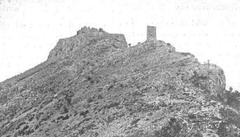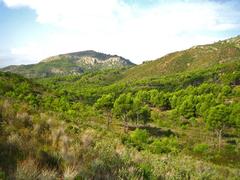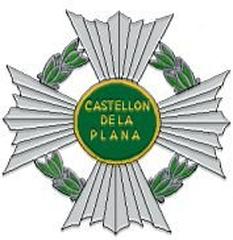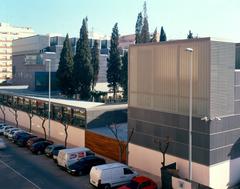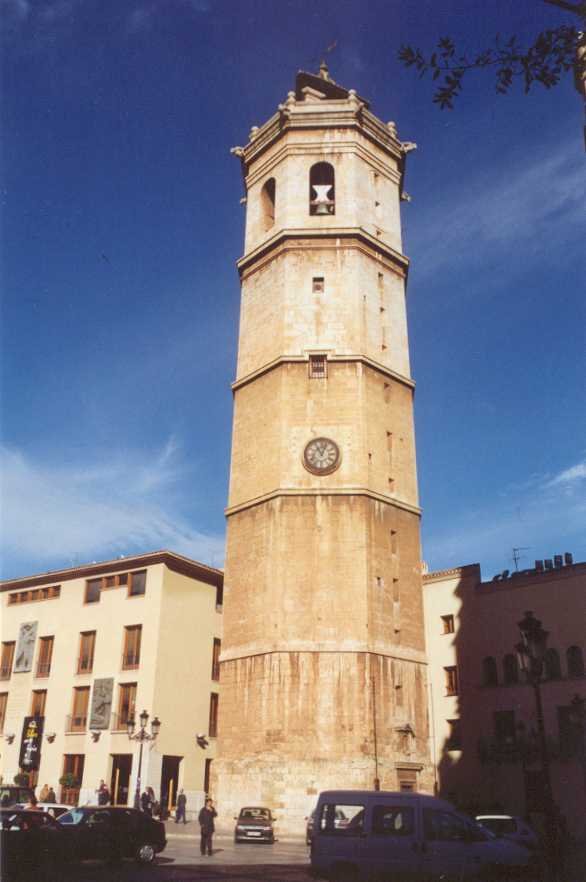
Visiting Guide to El Fadrí in Castelló de la Plana, Spain
Publication Date: 20/07/2024
Introduction to El Fadrí
El Fadrí, the iconic bell tower of Castelló de la Plana, Spain, stands as a remarkable testament to the city’s enduring history, rich cultural heritage, and architectural grandeur. Constructed between the late 16th and early 17th centuries, this freestanding tower is a quintessential example of Valencian Gothic architecture, reflecting the city’s growth and prosperity during the Renaissance period. Designed by the renowned architect Juan Baptista Porcar, El Fadrí’s octagonal shape and towering height of approximately 58 meters make it a unique and visually striking landmark (Castelló Tourism).
Originally commissioned to serve as the bell tower for the nearby Santa María Church, El Fadrí has played a significant role in both the religious and civic life of Castelló de la Plana. Over the centuries, it has witnessed numerous historical events, including its use as a lookout point during the War of Spanish Succession and the Carlist Wars. The tower’s bells, each with its own history and name, have been integral to marking time and calling the faithful to prayer, further embedding El Fadrí into the cultural fabric of the city (El Fadrí History).
Today, El Fadrí continues to be a vital part of the community, hosting cultural events, art exhibitions, and educational programs that keep its legacy alive. Visitors can explore the tower’s intricate Renaissance architecture, climb its narrow spiral staircase to enjoy panoramic views, and immerse themselves in the rich traditions and stories that El Fadrí embodies. This comprehensive guide aims to provide an in-depth look at El Fadrí’s history, architectural significance, visitor information, and much more, making it an essential resource for anyone planning to explore this iconic landmark.
Contents Overview
- Introduction
- History of El Fadrí
- Origins and Construction
- Architectural Significance
- Historical Events
- Restoration and Preservation
- Cultural Impact
- Modern-Day Relevance
- Visitor Information
- Visiting Hours
- Tickets
- Guided Tours
- Nearby Attractions
- Travel Tips and Accessibility
- Special Events and Photographic Spots
- FAQs
- Conclusion
History of El Fadrí
Origins and Construction
El Fadrí’s construction began in 1591 and was completed in 1604. Designed by architect Juan Baptista Porcar, the tower exemplifies the Renaissance architectural style prevalent during that period. It was commissioned by the local government to serve as a bell tower for the nearby Santa María Church, which dates back to the 13th century (Castelló Tourism).
Architectural Significance
Standing at approximately 58 meters tall, El Fadrí is characterized by its octagonal shape, a unique feature among bell towers in Spain. The tower is divided into four distinct sections: the base, the main body, the belfry, and the lantern. Each section has its own architectural features and significance. The base is solid and robust, designed to support the weight of the upper sections. The main body features a series of windows and decorative elements reflecting the Renaissance style. The belfry houses the bells, used for centuries to mark time and call the faithful to prayer. The lantern, at the top, provides a vantage point with panoramic views of the city and surrounding areas (El Fadrí History).
Historical Events
Throughout its history, El Fadrí has witnessed numerous significant events. During the War of Spanish Succession (1701-1714), the tower was used as a lookout point and a defensive structure. In the 19th century, during the Carlist Wars, it again served a strategic military purpose. The tower has also been a focal point for various religious and cultural celebrations in Castelló de la Plana, such as the annual Magdalena Festival, which commemorates the founding of the city (Magdalena Festival).
Restoration and Preservation
Over the centuries, El Fadrí has undergone several restoration projects to preserve its structural integrity and historical significance. One of the most significant restorations took place in the early 20th century, led by architect Vicente Traver Tomás. This restoration aimed to repair damage caused by natural wear and tear and to restore the tower’s original Renaissance features. More recently, in 2004, a comprehensive restoration project was undertaken to mark the 400th anniversary of the tower’s completion. This project included structural reinforcements, cleaning of the stone facade, and restoration of the bells and clock mechanism (Restoration Projects).
Cultural Impact
El Fadrí is not just a historical monument; it is a symbol of Castelló de la Plana’s cultural heritage. The tower is featured prominently in local folklore, literature, and art. It is a source of pride for the residents of Castelló and a must-visit landmark for tourists. The tower’s bells, in particular, have a special place in the hearts of the locals. Each bell has its own name and history, and they are rung in a specific sequence during religious ceremonies and festivals (Cultural Significance).
Modern-Day Relevance
Today, El Fadrí continues to be a vital part of Castelló de la Plana’s cultural and social life. The tower is open to the public, and visitors can climb to the top to enjoy breathtaking views of the city and the Mediterranean Sea. The tower also hosts various cultural events, including art exhibitions, concerts, and educational programs. These activities help to keep the history and significance of El Fadrí alive for future generations (Modern-Day Relevance).
Visitor Information
Visiting Hours and Tickets
El Fadrí is open to visitors from 10 AM to 6 PM daily. Tickets can be purchased at the entrance for €5. Guided tours are available for an additional fee (Visitor Information).
Accessibility
The tower is partially accessible to visitors with disabilities. The ground floor is wheelchair accessible, but the spiral staircase to the bell chamber may pose challenges.
Nearby Attractions
While visiting El Fadrí, consider exploring other nearby attractions such as the Santa María Church, the Central Market, and the Museo de Bellas Artes. These sites offer a deeper understanding of Castelló’s rich cultural and historical heritage.
Travel Tips and Accessibility
El Fadrí is easily accessible by public transport, and there are parking facilities nearby. It is advisable to check the weather forecast before your visit, as the climb to the top can be strenuous in extreme weather conditions. The tower is partially accessible to individuals with mobility issues, but the upper sections may pose a challenge.
Special Events and Photographic Spots
El Fadrí hosts several special events throughout the year, including religious ceremonies and cultural festivals. The tower and its surroundings offer excellent photographic opportunities, especially during sunrise and sunset when the lighting accentuates the architectural details.
FAQs
What are the visiting hours for El Fadrí?
El Fadrí is open from 10 AM to 6 PM daily. It is advisable to check the official website for the most up-to-date information.
How much are the tickets for El Fadrí?
The entrance fee is €5, with discounts available for students, seniors, and groups. For exact pricing, please refer to the official website.
Are guided tours available?
Yes, guided tours are available and provide in-depth information about the tower’s history, architecture, and cultural significance.
Conclusion
El Fadrí, with its towering presence and rich historical narrative, is more than just a monument; it is a symbol of Castelló de la Plana’s enduring cultural and architectural legacy. From its Renaissance origins to its role in significant historical events, El Fadrí encapsulates the spirit and resilience of the city. Its architectural beauty, characterized by its unique octagonal shape and intricate Renaissance details, continues to awe visitors and locals alike (Ajuntament de Castelló).
In addition to its historical and architectural significance, El Fadrí remains a vibrant part of the community, hosting numerous cultural events and educational programs that celebrate the city’s heritage. The annual Magdalena Festival, among other events, highlights the tower’s integral role in local traditions and festivities. Visitors are encouraged to explore not only El Fadrí but also the surrounding attractions such as the Santa María Cathedral and the Museo de Bellas Artes, enriching their understanding of Castelló de la Plana’s cultural landscape (Fiestas de la Magdalena).
As preservation efforts continue to maintain and restore El Fadrí, future generations will have the opportunity to experience and appreciate this iconic landmark. Whether you are a history enthusiast, an architecture aficionado, or a curious traveler, El Fadrí offers a glimpse into the past while standing as a beacon of cultural pride and historical significance. Plan your visit to El Fadrí today and immerse yourself in the rich tapestry of Castelló de la Plana’s heritage (Restoration Projects).
Sources and Further Reading
- Castelló Tourism. (n.d.). Retrieved from Castelló Tourism
- El Fadrí History. (n.d.). Retrieved from El Fadrí History
- Ajuntament de Castelló. (n.d.). Retrieved from Ajuntament de Castelló
- Fiestas de la Magdalena. (n.d.). Retrieved from Fiestas de la Magdalena
- Restoration Projects. (n.d.). Retrieved from Restoration Projects

